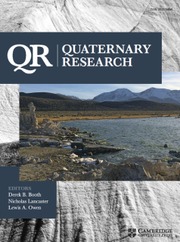No CrossRef data available.
Article contents
Introduction to special issue: loess environments: generation, transport, and deposition
Published online by Cambridge University Press: 27 September 2024
Abstract
An abstract is not available for this content so a preview has been provided. Please use the Get access link above for information on how to access this content.

- Type
- Preface
- Information
- Quaternary Research , Volume 120: Loess Environments: Generation, Transport, and Deposition , July 2024 , pp. 1 - 2
- Copyright
- Copyright © The Author(s), 2024. Published by Cambridge University Press on behalf of Quaternary Research Center
References
REFERENCES
Cui, J., Guo, L., Xiong, S., Yang, S., Wang, Y., Zhang, S., Sun, H., 2024. Soil organic carbon induces a decrease in erodibility of black soil with loess parent materials in northeast China. Quaternary Research 120, 83–92.Google Scholar
Fu, Y., Guo, Z., Wang, G., 2024. Seasonality of C4 plant growth and carbonate precipitation in the Chinese Loess Plateau may cause positive carbon isotope anomalies in pedogenic carbonates. Quaternary Research 120, 71–82.Google Scholar
Gu, Y., Lu, H., Wang, J., Zhang, H., Zhang, W., Liang, C., Wu, J., 2024. East Asian monsoon variations in the loess–desert transitional zone (northern China) during the past 14 ka and their comparison with TraCE21K simulation results. Quaternary Research 120, 53–61.Google Scholar
Li, W., Jiang, W., Yang, S., Lin, J., Wang, Y., 2024. Holocene hydroclimate and dust activity, as reconstructed from the sediments of Lake Bayanchagan, on the northern margin of the East Asian summer monsoon. Quaternary Research 120, 62–70.Google Scholar
Mason, J.A., Nater, E.A., Zanner, C.W., Bell, J.C., 1999. A new model of topographic effects on the distribution of loess. Geomorphology 28, 223–236.Google Scholar
Schaetzl, R.J., 2024. Loess transportation surfaces in west-central Wisconsin, USA. Quaternary Research 120, 36–52.Google Scholar
Skurzyński, J., Jary, Z., Fenn, K., Lehmkuhl, F., Raczyk, J., Stevens, T., Wieczorek, M., 2024. Implications of the geochemistry of L1LL1 (MIS2) loess in Poland for paleoenvironment and new normalizing values for loess-focused multi-elemental analyses. Quaternary Research 120, 18–35.Google Scholar
Taratunina, N.A., Kurbanov, R.N., Rogov, V.V., Streletskaya, I.D., Yanina, T.A., Solodovnikov, D.A., Stevens, T., 2024. Cryogenic features and stages in Late Quaternary subaerial sediments of the Lower Volga region. Quaternary Research 120, 3–17.Google Scholar
Zhang, S., Yang, S., Xiong, S., Guo, L., Wang, Y., Huang, X., Sun, M., Ding, Z., 2024. Origin and depositional background of the Holocene black soil in northeast China: evidence from grain-size analysis and optically stimulated luminescence dating. Catena 239, 107963.Google Scholar



